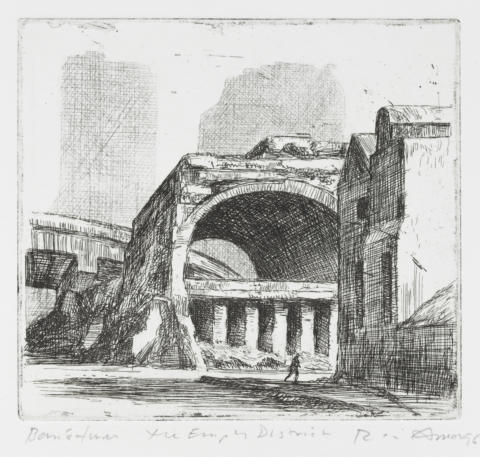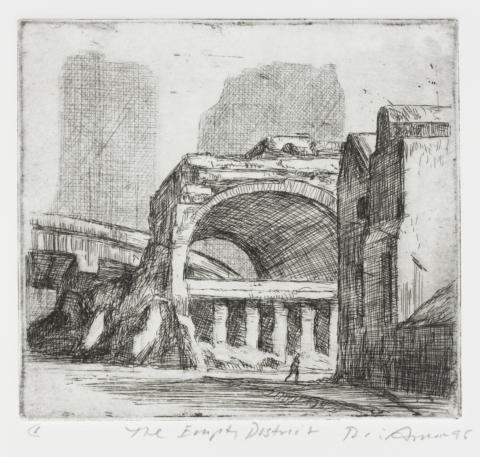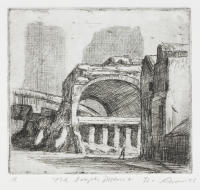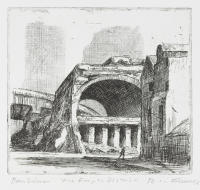
Etching. At the end of a street sits a huge, derelict, tunnel-like construction with an inner platform, raised on columns, and with crumbling masonry on top – a structure neglected in the wake of earlier building works. It is partially obscured at the right by nineteenth-century warehouses, which are situated at the corner of the two streets that intersect in front of it; on the street corner is a man, who walks towards the warehouses. To the left of and behind the tunnel is the curve of an elevated roadway. In the distance are the ghostly silhouettes of two tall modern buildings. The subject is lightly etched.
The left patch of white on the rubble at left has been darkened with horizontal lines of etching, and more etching has been added to the light face of the freeway curve, in order to clarify the structure. The inside of the concrete tunnel has been modelled with additional cross-hatching, which serves to accentuate both curve and depth; the spaces between the supporting pillars of the platform have also been darkened with cross-hatching. The pile of rubble at the front of the tunnel has been better defined, as has the diagonal edge of the footpath. The walking figure is now slightly darker and the shadow cast by the buildings at right has been extended at the left.
- Catalogue Number
- E.105
- Title and Date
- The empty district 1996
- Description of Featured Image
- At the end of a street sits a huge, derelict, tunnel-like construction with an inner platform, raised on columns, and with crumbling masonry on top – a structure neglected in the wake of earlier building works. It is partially obscured at the right by nineteenth-century warehouses, which are situated at the corner of the two streets that intersect in front of it; on the street corner is a man, who walks towards the warehouses. To the left of and behind the tunnel is the curve of an elevated roadway. In the distance are the ghostly silhouettes of two tall modern buildings.
- Where Made
- Alphington, Melbourne
- Medium Category and Technique
- Intaglio Print: Etching on copper
- Support
- Wove paper. Identified papers: BFK Rives paper with watermark: ‘BFK RIVES / FRANCE’ with infinity symbol.
- Dimensions
-
Image size: 130 x 142 mm
Matrix size: 130 x 144 mm - Artist’s Record Number
- RAE.112
- Printer(s) and Workshop(s)
- All impressions printed by Rick Amor in his Alphington studio.
- Summary Edition Information
- Two states. Nominal edition of ten, but only three impressions printed and numbered, 1996.
- Exhibitions
- University of Melbourne 2014: Ian Potter Museum of Art, University of Melbourne, Parkville (Melbourne), The Piranesi Effect, 20 February – 25 May 2014, no. 37, as The empty district (imaginary place).
- Literature
- For an illustration of the gouache Study for ‘The empty district’, 1996, see Niagara Galleries, Rick Amor (exh. cat.), Niagara Galleries, Richmond, Victoria, 1996, cat. no. 12.
- For an illustration of the painting The empty district, 2006, see Gavin Fry, Rick Amor, Beagle Press, Roseville, NSW, 2008, p. 176.
- Collections
- State Library of Victoria, Melbourne: one state impression, numbered 1; bon à tirer impression; ed. 3/10.
- National Gallery of Australia, Canberra: ed. 1/10, with plate tone, as The empty district (imaginary place) (2007.711).
- Comment
This etching is a composite view that includes nineteenth-century warehouses such as are found in the inner west of Melbourne. However, the main motif – a giant, derelict overground tunnel – is invented.
E.105 is based on a gouache, Study for ‘The empty district’, dated 29 January 1996 (Niagara Galleries 1996), but with the orientation of the composition reversed. The gouache was also the model for a painting made a decade later: The empty district, 2006 (Fry 2008).
Having established the essential elements of the composition in the first state of the etching, Amor turned his attention to rendering more effectively the scale and bulk of the abandoned tunnel. In the second state, by accentuating the depth of the structure, he amplified its emptiness and created a recession into the distance that acts like a vortex, drawing the eye to the centre of the image.
- Keywords
- Cityscapes & streetscapes, Roadworks
- URL
- https://catalogue.rickamor.com.au/works/intaglio/the-empty-district/
Record last updated 16/02/2021


